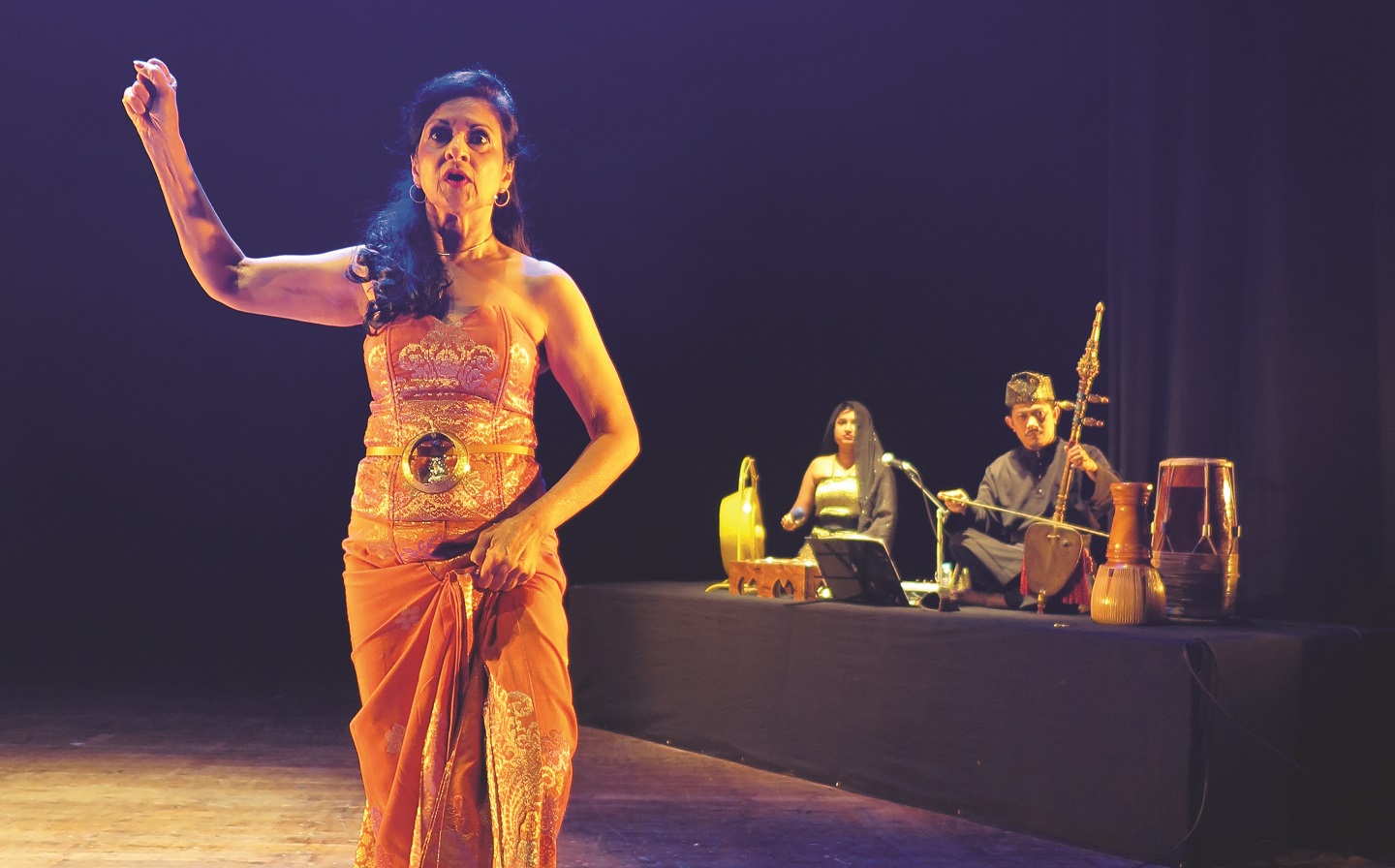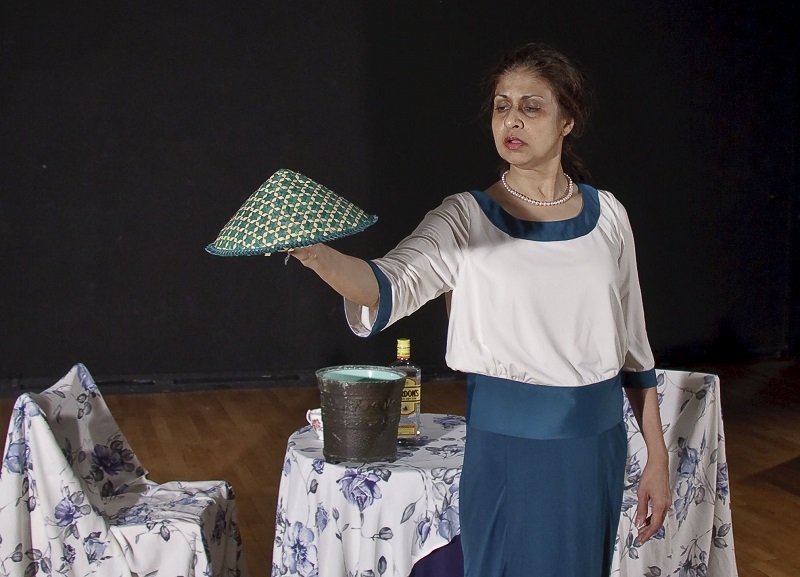
Sabera Shaik in Puteri Saadong (Photo: Masakini Theatre)
At a time when many are just ushering in the new year, Sabera Shaik is already in the final stages of her latest project — an after-dinner show series. The two performances will be held a week apart at Masakini Theatre Company’s spacious grounds and studio in Bukit Tunku.
“For the first one, on Jan 12, we have a typically English dinner of mulligatawny soup and Shepherd’s Pie. Then the weekend after, we have Kelantanese food. Both will be followed by a performance in the studio,” says Sabera, who is the founder and artistic director of Masakini.
The menus offer obvious clues to the two monodramas she will be performing — Lady Swettenham and Puteri Saadong. Both pieces have been performed internationally, the former having premiered in Denmark in 2009 before travelling to the UK, Malaysia, India, South Africa and Brazil. Puteri Saadong was performed most recently in Jaipur, India, last year.
Collectively, the two shows have earned Sabera a reputation for creating monodramas of female characters that are tied to Malaysian history and culture.
“You know, it’s that age-old saying, ‘A woman’s lot’. I feel that even today — no matter how we say women have grown to become this and that, or no matter how beautiful or talented a person is — there’s still a lack of [autonomy] in many cases. How many women today can say they are on an equal footing with the guys? How many Merkels and Thatchers [are there] in everyday life?” Sabera says, explaining what drew her to portray the characters.

She also felt compelled to reveal, or to imagine, the stories behind figures that have a fantastical reputation, a look “behind the scenes” that, through the stage, offer them a spotlight from their perspectives.
Sabera stumbled upon the mysterious Lady Swettenham’s story when a friend of hers, Datuk Henry Barlow, offered a read of the manuscript of his book in the 1990s. There was a chapter or two on former British resident-general Frank Swettenham’s marriage, which Sabera found strange and unusual.
Together with the late actor Ramli Hassan, she decided to research further and found an even more intriguing point. “There weren’t any pictures or photographs of her anywhere [in the archives]. And she was a well-known figure among British social circles during the 1800s. She used to play the piano at the Selangor Club, and in Perak, she was known as ‘the queen’ and had a hand in designing the Taiping Lake Gardens. There must have been photographs, and yet, she was just obliterated from everything,” explains Sabera.
Originally written as an ensemble piece, Lady Swettenham was reworked as an hour-long monodrama in 2009. It relates the lady’s suffering from manic depression, which landed her in London asylums regularly. She would eventually find out about her divorce in the newspapers.

The piece starts in an asylum, with Sabera playing 13 characters in total. “Here was this well-respected resident-general that many looked up to. But there was someone who lived with him. And I wanted to focus on her life, to maybe say, ‘Yes, he was fantastic, but this is what happened to me’. We’re all obsessed about appearances in this day and age, but if only we look behind the scenes more …” she says in explaining the wider significance of the story.
Incidentally, it is back to Holstebro, Denmark — where Lady Swettenham in monodrama form was first performed in collaboration with Tage Larsen of Odin Teatret — for Sabera at the end of this month. She will perform Puteri Saadong at the Teatret’s 2019 edition of the Nordisk Teaterlaboratorium festival. The after-dinner shows this month were organised partly as a fundraising initiative for her trip.
Sabera will be supported by Kelantan-born musician Kamrul Hussin, Susan Sarah John (of gamelan ensemble Rhythm In Bronze fame) and lighting designer Norma Nordin.
Puteri Saadong is a historical and mythical figure whose legend is larger than life and who has been the focus of various productions. Sabera’s version homes in on her as a person as well as her emotions. She reimagines Saadong’s childhood, how she became a sophisticated woman and leader and how, ultimately, anger against her husband led to a moment of madness and murder.
“She was not the only female ruler. There was also her stepmother, Cik Siti Wan Kembang, who was a really accomplished woman. But I felt Puteri Saadong’s story could stand alone better as a monodrama. Because her reign was so shortlived, I didn’t want to put in fillers and so went straight to the point with her story. What you get is an intense 56-minute performance,” the actor says.

That is not to say Sabera did not take creative license with certain details. While she eschewed the rumoured occult powers — Saadong was said to be able to lift the palace and move it to the mountains — she incorporated an anecdote about a naughty childhood by one of the local orang seni she spoke to during her research trips, while also fleshing out how travel would have been at that time, via elephants and horses.
Here, Sabera plays only the titular character, speaking to the audience directly as the story is accompanied by traditional music. “The show is one that travels really well because of its cultural and traditional elements. While it is a contemporary theatre piece in terms of form and language, it is a mythical story with traditional elements such as music and costumes made with specially woven songket. And how I walk in circular motions mimics the traditional style,” she highlights, adding that international audiences are particularly fascinated by Malaysia’s traditional cultures.
Despite having performed both works multiple times, capturing the audience’s attention with her sheer presence and effort is something that she is still perfecting.
She quips, “According to (Odin Teatret founder) Eugenio Barba, your show is not yet mature until you’ve done 40 performances … so it’s still a long way for me.”
'Lady Swettenham' (Jan 12) and 'Puteri Saadong' (Jan 19) will be staged at 8A, Jalan Tepian Tunku, Bukit Tunku, KL. Dinner starts at 7pm and the show at 8.30pm. Price is RM300 per person. Click here for more details. This article first appeared on Jan 7, 2019 in The Edge.


